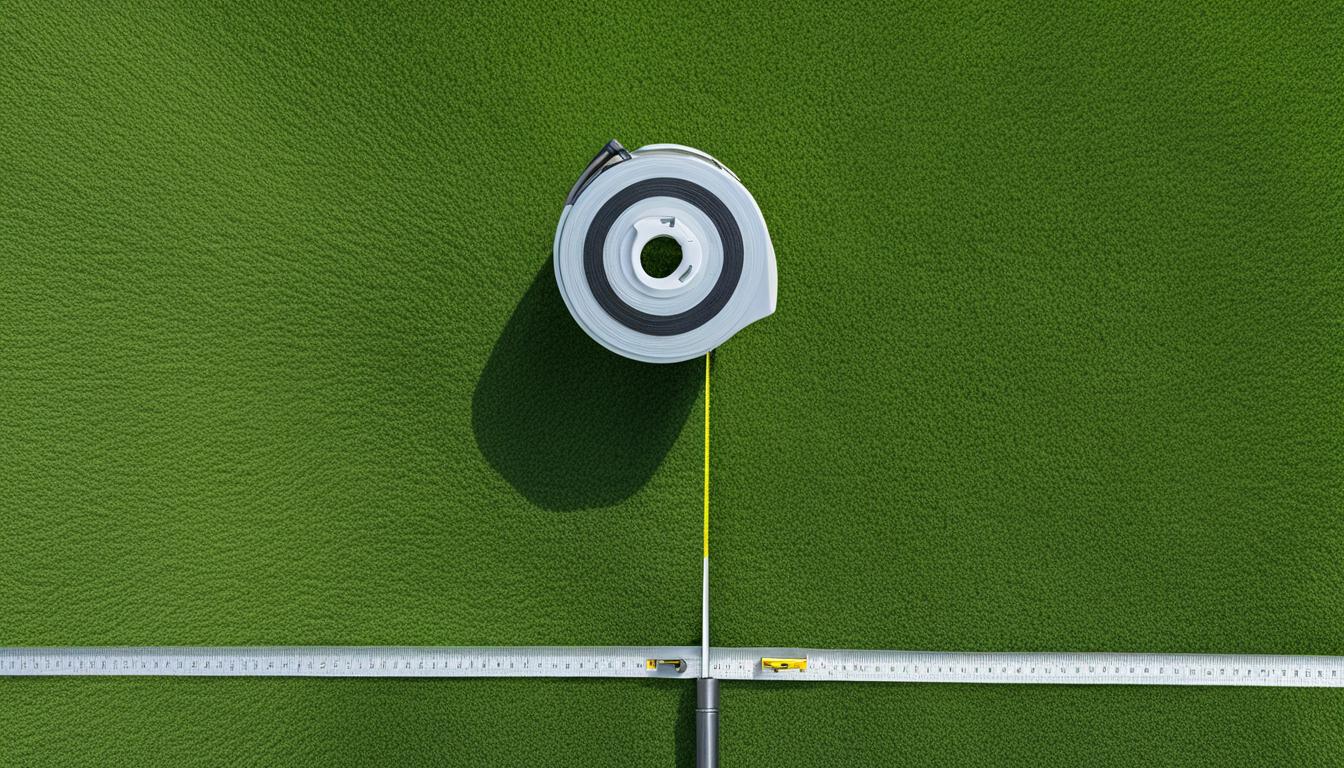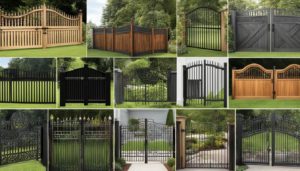Before starting a fence installation project, it is important to measure your yard accurately. By doing so, you can plan your budget, communicate effectively with a fence company, and ensure a smooth installation process. To measure your yard for a fence, you need to confirm your property lines, look for obstructions and utility lines, and take accurate measurements of the perimeter.
Key Takeaways
- Measuring your yard accurately is crucial for a successful fence installation.
- Confirm your property lines to avoid disputes with neighbors.
- Identify obstructions and utility lines to plan the placement of your fence.
- Measure the perimeter of your yard and calculate the number of fence panels needed.
- Work with a skilled fence contractor for worry-free installation, especially for gates and complex features.
Confirming Property Lines
Before proceeding with your fence installation, it is essential to confirm your property lines. This step is crucial to avoid any disputes with your neighbors and ensure that you stay within the boundaries of your own property. By confirming your property lines, you can adhere to fencing etiquette and maintain a good relationship with those living around you.
To determine the exact boundaries of your property, you have a few options. You can start by checking county records, which often provide information on property lines. Another reliable method is to consult with a land surveyor who can accurately measure and mark your property boundaries. By investing in this extra step, you can have peace of mind knowing that your fence will be installed in the right place.
Building a fence on your neighbor’s side of the property line can lead to costly legal issues and strained relationships. So, take the time to confirm your property lines before starting your fence installation project.
| Fencing Etiquette Tips: |
|---|
| 1. Communicate: Inform your neighbors about your fence installation plans and ensure they are aware of the intended location. |
| 2. Respect Boundaries: Always build your fence within your property lines to avoid encroaching on your neighbor’s land. |
| 3. Sharing Costs: If the fence will be shared with a neighbor, discuss and agree on the cost-sharing arrangements beforehand. |
| 4. Follow Regulations: Check local zoning laws and HOA guidelines to ensure your fence meets any height or style restrictions. |
Identifying Obstructions and Utility Lines
When measuring your yard for a fence, it’s crucial to identify any potential obstructions and utility lines that may affect the placement of your fence. By considering these factors, you can ensure a smooth installation process and avoid costly mistakes.
Firstly, take note of any permanent features in your yard, such as trees, large rocks, or structures. These obstructions may impact the placement of your fence, requiring you to adjust its position. Determine whether the fence needs to go in front of, behind, or near these features, taking into account any visual or functional considerations.
Additionally, it’s essential to locate any underground utilities like gas, electric, and cable lines. Contact the Utility Notification Center or call 811 to request a utility locate service. This will help you avoid accidentally damaging these lines during the fence installation process, which can be dangerous and costly to repair.
| Obstructions | Considerations |
|---|---|
| Trees | Determine whether the fence should go around the tree or incorporate it into the layout. |
| Structures | Ensure the fence does not obstruct access to sheds, garages, or other buildings. |
| Utility Lines | Take precautions to avoid damaging gas, electric, or cable lines during installation. |
By carefully identifying obstructions and utility lines, you can plan around them and ensure that your fence is installed without any issues. This will help you create a functional and visually appealing fence that meets your needs and enhances your property’s overall aesthetics.
Key Takeaways
- Take note of permanent features in your yard that may affect fence placement.
- Determine whether the fence needs to go in front of, behind, or near obstacles.
- Contact the Utility Notification Center or call 811 to locate underground utility lines.
Measuring Your Yard for a Fence
When it comes to installing a fence, accurate measurements are key to ensure a seamless and successful project. By measuring your yard properly, you can determine the right amount of materials needed and plan your budget accordingly. Here are the steps to follow when measuring your yard for a fence:
Step 1: Mark the corners
Start by marking the corners of your yard with stakes. This will serve as your reference points when measuring the perimeter. Make sure the stakes are secure and easily visible.
Step 2: Measure the perimeter
Using a taut tape measure, carefully measure the perimeter of your yard by running the tape from one corner to another. Take note of the measurements and ensure accuracy. If your yard has irregular shapes or angles, break it down into smaller sections and measure each one separately.
Step 3: Calculate the number of fence panels
Once you have the total perimeter measurement, divide it by the size of the fence panels you plan to use. This will give you an estimate of how many units you’ll need to enclose the entire area. Make sure to consider gate openings as well.
| Fence Panel Size | Length (ft) | Number of Panels Needed |
|---|---|---|
| 6ft x 8ft panels | 8 | XX |
| 6ft x 6ft panels | 6 | XX |
| 4ft x 8ft panels | 8 | XX |
Based on the measurements, refer to the table above to determine the number of fence panels needed for each panel size.
By following these steps, you can ensure accurate measurements when planning for your fence installation. Taking the time to measure properly will save you time and money in the long run, and ensure a fence that fits perfectly in your yard.
Budgeting and Detailed Measurements
When measuring your yard for a fence, it’s essential to consider your budget and take detailed measurements to ensure accurate installation. By following these steps, you can plan your expenses effectively and avoid any unforeseen costs:
- Mark the corners and line posts: Begin by placing stakes to mark the corners of your yard. These will serve as reference points for accurate measurements. Additionally, mark the spots where you plan to install line posts, which provide support for the fence panels.
- Run a string between the stakes: To create straight lines and maintain proper alignment, run a string between the stakes. This will help you visualize the fence’s layout and determine any adjustments needed to accommodate slopes or curves.
- Consider slopes and curves: If your yard has slopes or curves, it’s crucial to take additional measurements to ensure a proper fit. Measure the height difference between the highest and lowest points along the fence line, as well as any changes in elevation.
- Account for gate placement: If you plan to have gates in your fence, measure the desired width and height for each gate opening. Consider factors such as ease of access and any specific needs or restrictions you may have.
By carefully budgeting and taking detailed measurements, you can ensure that your fence installation is accurate and meets your specific requirements. Remember to consult with a professional fence contractor if you need expert advice or assistance with complex features such as slopes or gate installations.
Sample Table: Fence Installation Budget
| Expense | Estimated Cost |
|---|---|
| Fence panels | $X |
| Line posts and concrete | $X |
| Gates | $X |
| Hardware (nails, screws, hinges) | $X |
| Tools (post hole digger, level) | $X |
| Labor (if hiring a contractor) | $X |
| Permits and inspections | $X |
| Additional materials (gravel, soil) | $X |
| Total | $X |
Planning Fence Installation
When preparing to install a fence, proper planning is essential to ensure a successful and efficient process. By taking the time to carefully plan each aspect of your fence installation, you can avoid unnecessary challenges and ensure a finished product that meets your needs and preferences.
Drawing a Sketch
Start by drawing a sketch of your yard and house. This will help you visualize the layout and determine where you want to place your fence. Take note of any existing structures, trees, or other elements that could impact the fence’s placement. Consider any setback requirements from your property line and ensure that your fence complies with local regulations.
End Post and Gate Placement
Next, determine the placement of your end posts and gates. End posts are crucial as they provide stability and support for your fence. They should be placed at the corners of your fence and at any points where the fence will change direction. Gates should be strategically placed to provide convenient access to your yard while maintaining security.
| Fence Placement Tips | |
|---|---|
| Consider the flow of foot traffic in your yard when deciding on gate placement. | |
| Ensure gates are wide enough to accommodate larger items, such as lawn equipment or furniture, that may need to be moved in and out of your yard. | |
| Place end posts at least 36 inches deep in the ground to provide sufficient stability. |
Calculating Materials
To determine the materials you’ll need for your fence, measure each side of your fence and calculate the total length. Consider any obstructions or changes in elevation that may require additional materials or adjustments. This will ensure that you purchase the right amount of fencing materials and avoid any unnecessary expenses or delays.
By carefully planning your fence installation and considering factors such as end post placement, gate placement, and material calculations, you can ensure a successful and efficient project. Taking the time to plan ahead will save you time, money, and potential headaches down the road.
Benefits of Working with a Fence Expert
When it comes to installing a fence, working with a skilled fence contractor can provide numerous benefits. From accurate measurements to worry-free service, a professional can ensure a smooth and successful installation process. Here are some key advantages of hiring a fence expert:
Expertise and Experience
A fence contractor brings a wealth of knowledge and experience to the table. They have a deep understanding of different types of fences, materials, and installation techniques. By working with a professional, you can benefit from their expertise and ensure that your fence is installed correctly and efficiently.
Accurate Measurements
Measuring your yard for a fence can be a challenging task, especially if there are obstacles or uneven terrain. A fence expert knows how to take precise measurements and account for any obstacles or curves in your yard. This ensures that your fence fits perfectly and provides maximum security and privacy.
Worry-Free Service
Installing a fence on your own can be a time-consuming and stressful process. By hiring a fence contractor, you can enjoy a worry-free service. They will take care of all the necessary permits, materials, and equipment, saving you time and effort. You can rest assured knowing that your fence installation is in capable hands.
Gate Installation and Functionality
If your fence includes a gate, a fence expert can ensure that it is properly installed and functions smoothly. They have the knowledge and tools to handle gate installation, including the necessary hardware and adjustments for smooth operation. With a professional fence contractor, you can avoid common gate installation issues and enjoy the convenience of a functional gate.
Working with a fence expert offers numerous benefits, from accurate measurements and worry-free service to expert advice and gate installation. By hiring a professional, you can ensure a successful fence installation and enjoy the benefits of a well-designed and functional fence for years to come.
Conclusion
Measuring your yard for a fence is a crucial step in the planning and installation process. By following the steps outlined in this guide, you can accurately measure your yard, plan your budget, and communicate effectively with a fence company or contractor. Taking the time to measure properly will ensure a successful and hassle-free fence installation.
Confirming your property lines is essential to avoid any disputes with your neighbors. Always double-check county records or consult with a land surveyor to determine the exact boundaries of your property. Building a fence on your neighbor’s side of the property line can result in expensive mistakes.
Identifying obstructions and utility lines is key to planning the placement of your fence. Look for permanent features such as trees or structures that may affect the fence’s positioning. Additionally, make sure to locate underground utilities like gas, electric, and cable lines. Contact the Utility Notification Center or call 811 for assistance.
When measuring your yard, start by marking the corners with stakes and use a taut tape measure to determine the perimeter. Divide the total length by the size of the fence panels you plan to use to estimate how many units you’ll need. This will give you a clear idea of the materials required for your project.
FAQ
Why is it important to measure my yard accurately before installing a fence?
Accurate measurements help in planning your budget, communicating effectively with a fence company, and ensuring a smooth installation process.
How do I confirm my property lines?
You can check county records or consult with a land surveyor to determine the exact boundaries of your property.
What should I consider when looking for obstructions and utility lines?
Look for permanent features such as trees or structures that may affect the placement of your fence, and contact the Utility Notification Center or call 811 to locate underground utilities.
How do I measure the perimeter of my yard?
Start by marking the corners of your yard with stakes and use a taut tape measure to measure the perimeter. Divide the total length by the size of the fence panels you plan to purchase to estimate how many units you’ll need.
How can I take more precise measurements?
Mark the spot for each corner and line post, run a string between the stakes, and create a sketch of your yard and house to keep track of measurements. Consider any setback requirements from your property line and account for obstructions or changes in elevation.
What should I plan for when it comes to fence installation?
Plan for the placement of end posts, gate placement, and the number of fence panels needed.
Should I work with a fence contractor?
While measuring for a fence is manageable for a DIY project, working with a skilled fence contractor ensures accurate measurements, proper installation, and expertise in dealing with more complex features like gates.
Why is measuring accurately important for a fence installation?
Accurate measurements ensure a successful and hassle-free fence installation, allowing you to plan your budget effectively and communicate with a fence company or contractor.




